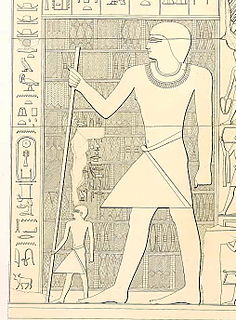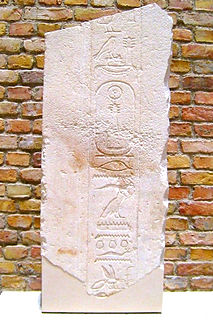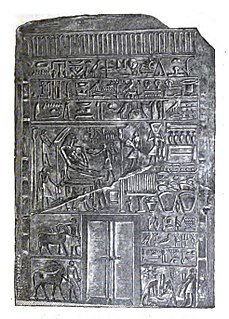
Saqqara, also spelled Sakkara or Saccara in English, is a vast, ancient burial ground in Egypt, serving as the necropolis for the Ancient Egyptian capital, Memphis. Saqqara features numerous pyramids, including the world-famous Step pyramid of Djoser, sometimes referred to as the Step Tomb due to its rectangular base, as well as a number of mastabas. Located some 30 km (19 mi) south of modern-day Cairo, Saqqara covers an area of around 7 by 1.5 km.
Teti, less commonly known as Othoes, sometimes also Tata, Atat, or Athath in outdated sources, was the first pharaoh of the Sixth dynasty of Egypt. He is buried at Saqqara. The exact length of his reign has been destroyed on the Turin King List but is believed to have been about 12 years.

Neferirkare Kakai was an ancient Egyptian pharaoh, the third king of the Fifth Dynasty. Neferirkare, the eldest son of Sahure with his consort Meretnebty, was known as Ranefer A before he came to the throne. He acceded the day after his father's death and reigned for eight to eleven years, sometime in the early to mid-25th century BCE. He was himself very likely succeeded by his eldest son, born of his queen Khentkaus II, the prince Ranefer B who would take the throne as king Neferefre. Neferirkare fathered another pharaoh, Nyuserre Ini, who took the throne after Neferefre's short reign and the brief rule of the poorly known Shepseskare.

Menkauhor Kaiu was an Ancient Egyptian pharaoh of the Old Kingdom period. He was the seventh ruler of the Fifth Dynasty at the end of the 25th century BC or early in the 24th century BC.

Nyuserre Ini was an Ancient Egyptian pharaoh, the sixth ruler of the Fifth Dynasty during the Old Kingdom period. He is credited with a reign of 24 to 35 years depending on the scholar, and likely lived in the second half of the 25th century BCE. Nyuserre was the younger son of Neferirkare Kakai and queen Khentkaus II, and the brother of the short-lived king Neferefre. He may have succeeded his brother directly, as indicated by much later historical sources. Alternatively, Shepseskare may have reigned between the two as advocated by Miroslav Verner, albeit only for a few weeks or months at the most. The relation of Shepseskare with Neferefre and Nyuserre remains highly uncertain. Nyuserre was in turn succeeded by Menkauhor Kaiu, who could have been his nephew and a son of Neferefre.
Ptahhotep, sometimes known as Ptahhotep I or Ptahhotpe, was an ancient Egyptian vizier during the late 25th century BC and early 24th century BC Fifth Dynasty of Egypt.

The Tomb of Perneb is a mastaba-style tomb from ancient Egypt, built during the reigns of Djedkare Isesi and Unas, in the necropolis of Saqqara, north of Pharaoh Djoser's Step Pyramid and about 30 kilometers south of Giza, Egypt. It was the tomb of Perneb, and from the size and placement of the tomb he might have been a court official or royal family member.

Isesi-ankh was an Ancient Egyptian high official during the second half of the Fifth Dynasty, in the late 25th to mid 24th century BC. His name means "Isesi lives". He may have been a son of pharaoh Djedkare Isesi and queen Meresankh IV, although this is debated. Isesi-ankh probably lived during the reign of Djedkare Isesi and that of his successor Unas. He was buried in a mastaba tomb in north Saqqara, now ruined.
Neserkauhor was an Ancient Egyptian prince, son of pharaoh Djedkare Isesi, during the second half of Fifth Dynasty. Neserkauhor was buried in Abusir, in an area known today as "Djedkare's family cemetery".

Rashepses was a vizier from the Fifth dynasty of Egypt. Rashepses was vizier under Djedkare Isesi. A letter directed to Rashepses has been preserved. This decree is inscribed in his tomb in Saqqara. As vizier he was one of the most important Ancient Egyptian officials. In his tomb are many titles recorded. It seems that he was first overseer of the scribes of the royal documents, overseer of the two granaries and overseer of all royal works. These are all very important titles, making him an influential official at the royal court. At the final stage of his career he became vizier. The vizier title is only preserved in two letters that are copied on the decoration of the tomb. It seems that most of his tomb was finished and after all that, he was promoted.

The Giza West Field is located on the Giza Plateau, to the west of the fourth dynasty Pharaoh Khufu’s pyramid. It is divided up into smaller areas like the cemeteries known as the Abu Bakr Excavations, as well as several cemeteries whose toponyms are based on the mastaba numbers such as Cemetery G 1000 and Cemetery G 1100. The West Field contains Cemetery G1000 – Cemetery G1600, and Cemetery G 1900. Further cemeteries in this field are: Cemeteries G 2000, G 2200, G 2500, G 3000, G 4000, and G 6000. Three other cemeteries are named after their excavators: Junker Cemetery West, Junker Cemetery East and Steindorff Cemetery.

Akhethetep was a high dignitary of Ancient Egypt who lived during the Fifth Dynasty around 2400 BC. Akhethotep and his son Ptahhotep Tjefi were senior court officials during the rule of Djedkare and of Unas (Wenis), towards the end of the 5th dynasty. Akhethetep's titles included that of a vizier, making him to the highest official at the royal court, only second to the king. He was also overseer of the treasuries, overseer of the scribes of the king's documents and overseer of the granaries. Akhethetep was the son of Ptahhotep. His father was vizier too.
Kaemtjenent was an Ancient Egyptian official under pharaoh Djedkare Isesi in the late Fifth Dynasty, during the Old Kingdom period.

Seshemnefer was an ancient Egyptian official of the Fifth Dynasty, most likely under king Djedkare Isesi. At the end of his career he became vizier, the highest office in Ancient Egypt, second only to the king.
Ptahhotep Desher was an Ancient Egyptian official at the end of the Fifth Dynasty, most likely in office under kings Menkauhor Kaiu and Djedkare Isesi. His main function was that of a vizier. This was the most important office in Ancient Egypt, second only to the king. Ptahhotep also held other titles, such as overseer of the six great houses, overseer of the scribes of the royal documents and overseer of all royal works. These are all important functions, often held by a vizier.
Minnefer was an Ancient Egyptian official in the reign of king Nyuserre Ini. He bears the titles of a vizier and was therefore the highest official at the royal court, second only to the king. He was also overseer of all royal works, a title often held by viziers. Minnefer is known from different sources. He is depicted in the funerary temple of king Nyuserre Ini at Abusir providing firm evidence for his dating under this king. He is named on a short quarry-mark painted on a stone that was found in a wall around the pyramid complex of king Neferirkare Kakai. He is mentioned in papyri found at Abusir, that dates under Djedkare Isesi. He is also known from his sarcophagus that is now in the Rijksmuseum van Oudheden in Leiden. His mastaba was found at Saqqara. It is not yet published. The quarry marks on the pyramid of Neferirkare Kakai indicate that he helped building his pyramid. Neferirkare Kakai ruled before Nyuserre. That means that Minnefer was either very long in office, or that the pyramid complex was finished under Nyuserre. The reference under king Djedkare Isesi refers to a phyle named after Minnefer. That might indicate that the vizier was later honored, perhaps with the cult of a statue.
Ptahhotep Tjefi, also called Ptahhotep II was an Ancient Egyptian official who lived at the end of the Fifth Dynasty, most likely under king Djedkare Isesi and under king Unas. His main function at the royal court was that of the vizier, making him to the most important man at the court, only second to the king. Ptahhotep, whose second name was Tjefi came from an influential family. His father was the vizier Akhethetep. His grandfather was the vizier Ptahhotep (I). Ptahhotep is mainly known from his mastaba at Saqqara. The burial complex was built for him and his father Akhethetep.
Ptahhotep was an ancient Egyptian official of the Fifth Dynasty, most likely under king Djedkare Isesi. His most important office was that of a vizier, making him to the most important official at the royal court, only second to the king. Next to this important office he hold further important titles, such as Overseer of the treasuries, overseer of the scribes of the king's document, overseer of the six big houses and overseer of all royal works of the king.

















